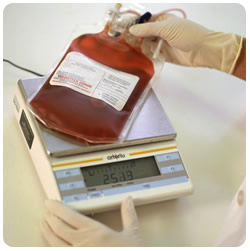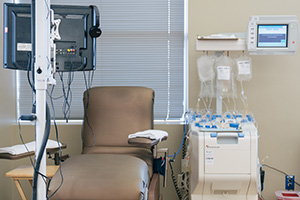What are Platelets?
Platelets are blood cells that help control bleeding. When a blood vessel is damaged, platelets collect at the site of injury and temporarily repair the tear. You can think of platelets like bricks that gather together at a blood vessel tear. After the platelets are activated, plasma then helps the blood clot by holding the platelets together. You can think of plasma as the cement that stabilizes the platelet bricks. Once a clot is formed, the wound can heal.

Apheresis
Apheresis (ay-fur-ee-sis) is a special kind of blood donation that allows a donor to give specific blood components, such as platelets. During the apheresis procedure, all but the needed blood components are returned to the donor.
Why is Blood Separated?
Different patients need different types of blood components, depending on their illness or injury. Since blood can be in short supply, we make your donation as efficient as possible. After you donate whole blood, the unit is separated into platelets, red cells, and plasma in the laboratory. Because platelets make up only a small fraction of whole blood, six whole blood donations are needed to provide a single platelet transfusion. However, one apheresis donation can provide enough platelets for one complete transfusion — that's six times the amount of platelets collected from a whole blood donation.
Who Can Benefit from a Platelet Donor?
Many lifesaving medical treatments require platelet transfusions. Cancer patients, those receiving organ or bone marrow transplants, victims of traumatic injuries, and patients undergoing open-heart surgery require platelet transfusions to survive.
Who Can Be a Platelet Donor?
If you meet the requirements for donating blood, you can probably donate platelets.
Platelet donors must meet the following requirements:
- Be at least 18 years old
- Be in good health
- Weigh at least 110 pounds
- Not have taken aspirin or products containing aspirin within 48 hours prior to the donation

Are Platelet Donations Safe?
Yes. Each donation is closely supervised throughout the procedure by trained staff. If you donate platelets through apheresis, you will not be at risk of bleeding problems since only a small percentage of your platelets are collected. In fact, your body will replace the donated platelets within about 72 hours. Also, the donation equipment (the needle, tubing, and collection bags) is sterile and discarded after every donation, making it virtually impossible to contract a disease from the process.
How Does the Platelet Apheresis Procedure Work?
Blood is drawn from your arm through sterile tubing into a centrifuge. The centrifuge spins the blood to separate the components, which vary in weight and density. A port is opened along the spinning tubing at the level containing platelets. These platelets are drawn up into a collection bag, while the remaining blood components (the red cells and plasma) are returned to you through your arm. The procedure can be done using one or both arms.
How Long Does It Take?
Depending on your weight and height, the platelet collection process will take approximately 80 minutes to two hours. You may watch available streaming services, listen to music, or simply relax, enjoy views of the Wasatch Front while helping save a life.
How Often May I Donate Platelets?
You may donate platelets every 10 days and up to 23 times per year.
How Can I Become a Platelet Donor?
Simply talk to your technician or call ARUP Blood Services at 801-584-5272 regarding the platelet donation process. Then, let us know the day and time you would like to donate, and we will schedule you an appointment.
